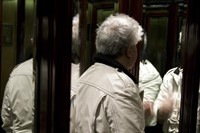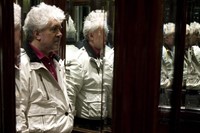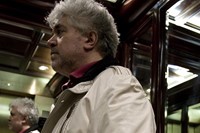Recently in New York for the premiere of his new film, The Skin I Live in, director Pedro Almodóvar caught up with New York Minute columnist Derek Peck. Here, he discusses objects and symbolism, love, his interest in noir and thrillers and the
Pedro Almodóvar was recently in New York for the premiere of his new film, The Skin I Live In, at the New York Film Festival. Some months ago, my editors and I decided that it might be nice to meet occasionally with non-New York artists as they’re passing through town, musing that it would lend itself well to the “New York Minute” theme. Naturally, I jumped at the opportunity to meet with Almodóvar, one of the true great living auteurs.
When I arrive at his suite at the Peninsula Hotel I notice a book on the coffee table that I had just seen a couple of nights earlier in his film. It’s a collection of short stories by Alice Munro, a Spanish edition titled Escapada (Escape), though the title in English is Runaway.
Making a brief appearance, it served as a visual cue inserted at just the right moment in a story about abduction, captivity, and physical transformation against one’s will. I ask him if it’s the book in the film. “Yes,” he says, “that is the one. I like her very much as a writer, but I have lots of these things in my movies, various clues and references. Of course, they are there as part of the movie, the story, so if you watch it two or three times you can still discover things. But I don’t only do it for the story and the audience; they are there also for me.”
Even as these words are rolling off his tongue in accented English, I am struck by something interesting about the man: his incredible honesty – about his art and motivations – and, even more so, his passion and joy in making films. Almodóvar is a man visibly in love with what he does, and he has developed little ways of entertaining himself in the process of making his art. Many of the objects he places in his films are personal to him. They help him to tell the story and they are links from this world into his created one.
You mentioned how you place certain objects in your films as symbols and markers, such as books and art. What I found interesting is how you said you do this not only for the audience as cues and added layers in the story, but also for yourself as signposts in the making of the film. Could you comment more on this and your relationship to the objects you place within the films?
In The Flower of My Secret, when the writer Leo Macías has just broken up with her husband, she picks up a framed photo that she has on her bedside table (the frame is made of transparent marbles and in the centre there is a small photo of Leo kissing her husband), she hurls it with fury on the floor and there’s a great crash. The pile of marbles, freed from the frame that contained them, bounce on the wooden floor, as if the frame had disintegrated. It is a doubly cinematic effect, that is, sonorous and visual. As well as throwing 'the kiss with her husband' on the floor, the scattered marbles bouncing on the floor multiply the sensation of destruction and violence. I’d bought the frame a few months before in a museum in New York (the MOMA or the Guggenheim) because I really liked it as an object. I usually buy many more things than I need because 'I know' that many of them will end up in a film, in the environment of one of the characters I still don’t know. I found the 'scuba diver' from Tie Me Up, Tie Me Down in an American airport, in LA or NY. During preparation for the film, when I was planning the scene in the bath in which Marina, Victoria Abril’s character, is thinking of the two men who had wooed her, the script only said that while she is bathing she thinks of the desire of those two very different men. Suddenly I remembered that I had the scuba diver at home and I decided to include it in the scene. For me, the scuba diver represents in a very physical way the desire of the two men who had just approached her, a desire that is directed at her vagina but ends up waiting at the door. I was so delighted I’d bought it at the airport and hadn’t given it to my nephew! I could give you a thousand examples like that.
You told me that as you’ve gotten older you’ve become more interested in noir and thrillers. Why do you think that is?
I was a great reader of crime novels when I was young, however it was when I got older that I came to value more the film version of that genre. For me 'noir' is a sublimation of melodrama. If you strip melodrama, as I understand it, of humour, the fatality acquires greater importance, and fatality is a determining element in “films noir”. I needed to let time pass, to live a more solitary, indoor life in order to become interested in thrillers. But I don’t mean that this is a necessary route....
What role does love play in your films?
I only conceive of characters driven by an irrational, passionate love that is linked to desire. In real life it can be annihilating, but those are the stories I like to tell. Desire, when it coincides with love, can move mountains, and it certainly dynamites the narrative enormously. I’m talking about love between people, but one can and should feel love/passion for many things, and that also forms part of my characters.
You discovered the process of using self-interview through reading Truman Capote’s self-interview. Could you share a bit more about how you use this technique as a tool of self-inquiry and creativity.
Dialogue is a literary genre in itself, as important in cinema as in theatre, and for me a self-interview is a form of dialogue. In my films, the characters talk a lot, they express themselves through all the means possible, but especially through words (Talk to Her, for example). A few times I’ve interviewed other people, normally artists about whom I am passionate. The last of these interviews was with Jeanne Moreau and it was published in Vogue France about a year ago. Jeanne Moreau is one of my favourite living actresses and I enjoyed enormously the three hours we spent chatting. I think I can only interview people I really like, I mean, I don’t think I have a journalist’s ability. Unless it’s myself, I can talk to myself at any time. I discovered it in the 80s, after reading Truman Capote’s self-interview. I did my first self-interview immediately and by chance it appeared in a book published about me. You could analyse my changes of mood, the changes in my life in general, by simply comparing the different and multiple interviews I’ve done with myself over time. A self-interview allows me to reflect on myself, it’s like thinking aloud. I don’t think I have a schizoid personality, but I have no difficulty in splitting myself in two, the one who asks and the one who answers. I’ve probably developed that capacity because I’ve always written, I’m used to putting myself in the place of other characters and talking for them. I never lie, or try to show myself as different from what I am, or how I think I am. It’s a good exercise in introspection and it helps me talk about aspects of my films and my life about which I’m not normally asked.
On your desk there was a sheaf of papers that you said is “supposed to be the next one....” Can you give us a hint?
It’s too early to give clues, I’m working on various stories, although there are two that stand out over the rest and I guess one of those two will become the next film. What I can tell you is that I’m going to change register. It will be very different from The Skin I Live In.
The Skin I Live In is screening in cinemas in NY now.



